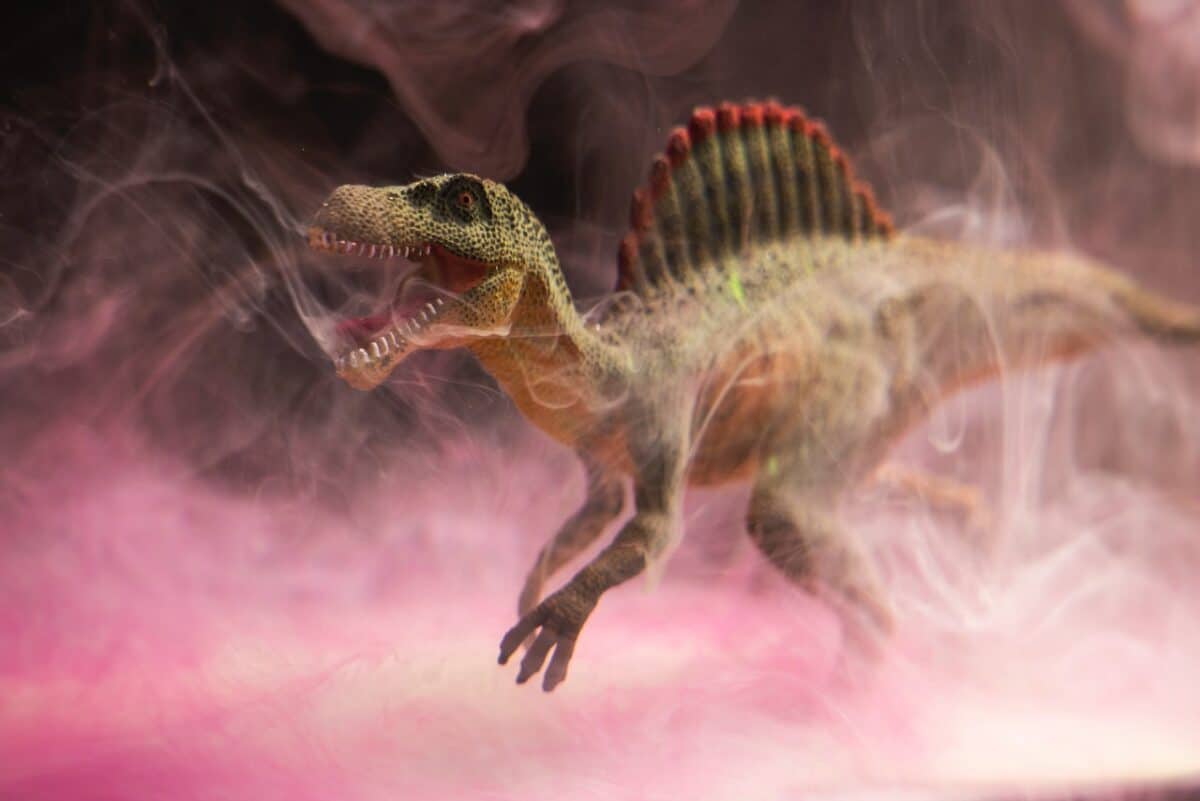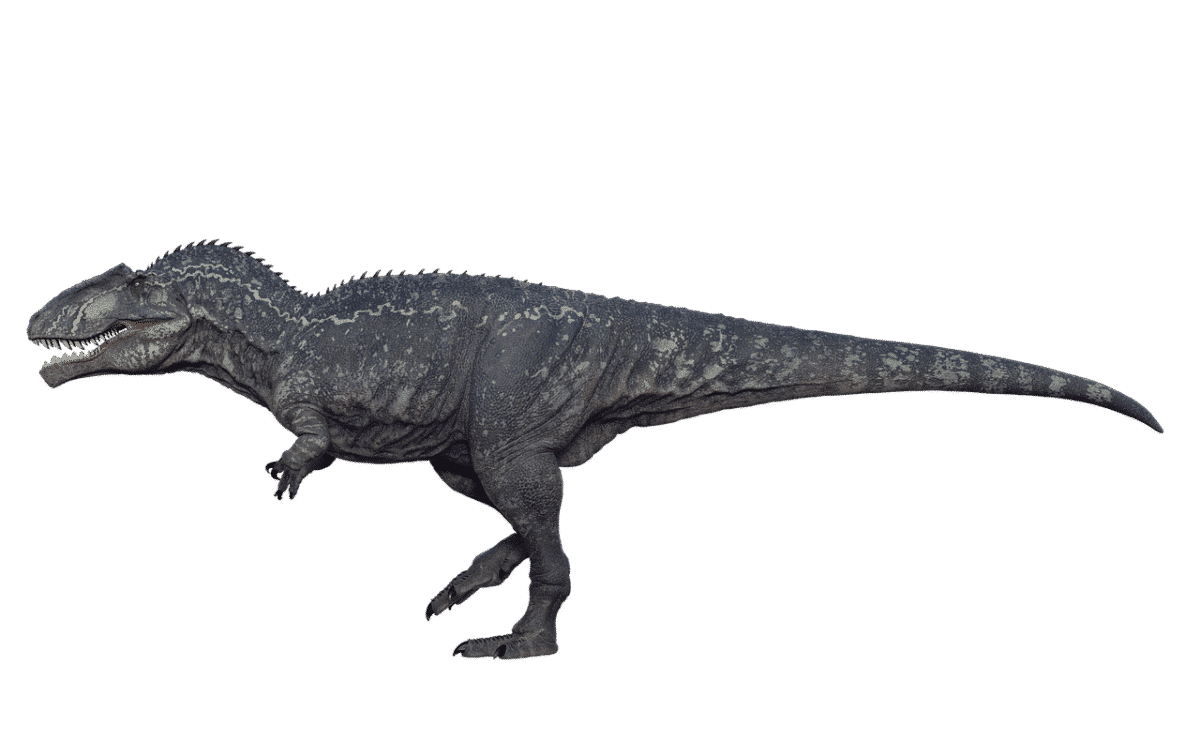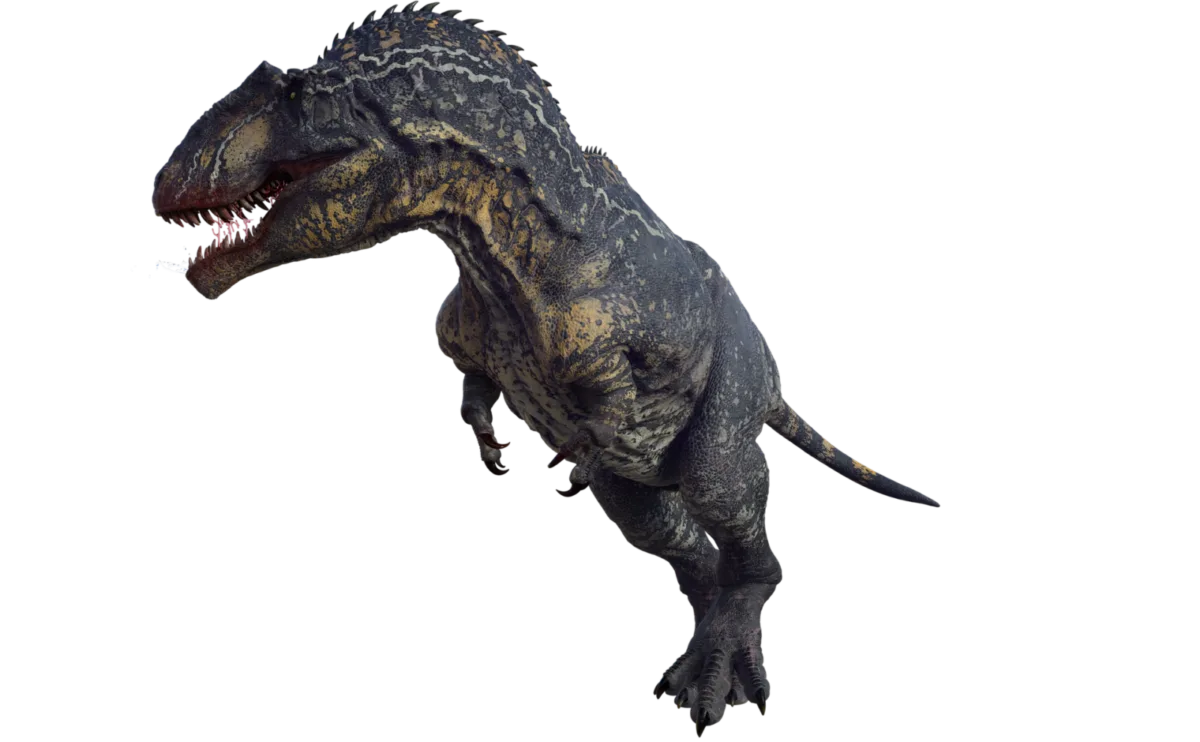Spinosaurus vs. Giganotosaurus, who wins the fight? If you are curious to know interesting facts about their size, intelligence, bite power, diet, and much more, then you are indeed in the right place. Here you are going to get complete information about each of the species.

Durbed, CC BY-SA 3.0, via Wikimedia Commons
These two breeds of dinosaurs are massively powerful and huge animals. The Spinosaurus is considered one of the absolute largest carnivorous dinosaurs in the world to ever exist. On the other hand, the Giganotosaurus is a massive animal that moves from toe to toe.
In this article, you’ll learn about the key features and characteristics of both dinosaurs. So, let’s dive into the discussion and compare both animals, uncovering intriguing facts about both of these lethal hunters.
Comparing a Spinosaurus and Giganotosaurus
| Spinosaurus | Giganotosaurus | |
| Size | 15,000 to 31,000 pounds 40 to 42 feet in length | 8,400 to 17,600 pounds 45 feet in length |
| Speed and Movement Type | 15 mph (Bipedal striding) | 31 mph (Bipedal striding) |
| Bite Power | 4,200 PSI | 6000 PSI |
| Intelligence | Large brain size and very intelligent | Smaller brain but nonetheless showed intelligent behavior |
| Senses | Strong senses to sense movement of fish in the dark and deep water | Crocodiles like senses to alert them of the presence of prey around them |
| Offensive Powers | 64 conical and straight teeth 6 inches long teeth Have the ability to chase prey inside and outside water | 76 serrated teeth 8 inches long teeth Sharp claws Ability to knock over foes |
| Predatory Behavior | Their cone-like teeth and sharp claws helped it to catch prey quickly and kill it. | Their powerful biting force and large size helped it to kill a prey without inconvenience. |
Spinosaurus

Some of the characteristics of the Spinosaurus that you would love to know and that will help you to distinguish it from Giganotosaurus are as follows:
Appearance
Spinosaurus belongs to spinosaurids; it has a long narrow skull that resembles the skull of a crocodile and has nostrils near its eyes, which are located near the end of the snout. The teeth of the animal are conical and straight but not bladelike or curved as compared to other theropods. The skeleton’s bones are denser and more compact, so they have greater control over water activity than when they are running on land. They show more control over the buoyancy under the water.
Moreover, researchers argue that Spinosaurus was primarily an aquatic predator in the world as compared to terrestrial.
Spinosaurus Diet
The Spinosaurus was a carnivore and had large teeth to engulf and chew animals. They had razor-sharp teeth for grabbing slippery prey like fish.
While swimming, they could easily catch fish with their hands. Scientists have found fossils of dinosaurs that have shown traces of fish in their digestive tract. They also consumed smaller land animals like small dinosaurs since their fossils also show evidence of left overs of small dinosaurs in their body.
Geographical Distribution of the Spinosaurus
The Spinosaurus inhabited Algeria around the Guir Basin or Kem-Kem beds, Egypt, Morocco, and Tunisia. Three different species of Spinosaurus fossils are found in these regions.
Some of the fossils have been found in the Cenomanian rocks of Africa and the Middle Cretaceous of Africa. The fossil record shows a 20-million-year persistence of these animals in the Gondwanan ecosystem.
Spinosaurids are also found to be residents of northern Brazil and western Europe territories. Thus, the geographical distribution of the Spinosaurus indicates that they inhabited different regions of the world.
Giganotosaurus

The Giganotosaurus is so named because of its large size. The gigas mean giant, and saros means lizard. In other words, they have the appearance of a giant lizard.
Appearance
Giganotosaurus was one of the largest terrestrial carnivores that roamed during the late Cretaceous period. Along with their massive body size, they had sharp teeth and long heavy tails that helped them balance their body. The head of the Giganotosaurus was relatively bigger than its body. Their sharp, serrated teeth allowed them to munch the meat of their various prey quickly. Also, the arms were relatively small compared to the body, but powerful enough to grasp the predator speedily and deliver the deadly blow.
Giganotosaurus Diet
Giganotosaurus were carnivores, too, and relied on meat. It has been researched that they used to eat herbivore dinosaurs like the sauropod. They were strong animals because, according to scientists, the bite force was three times more than other dinosaur species. They could break and crush bones easily. Also, Giganotosaurus had cutting claws in their hands that were used to kill prey before their meat was devoured.
Geographical Distribution
One of the largest animals of its time lived during the Cretaceous period. Its fossils are found in Argentina and South American territories. The region comprises the candeleros formation near the state of Argentina named Patagonia. The fossils were deposited in the early Cenomanian age in the late period of the Cretaceous.
Key Differentiating Factors Between the Spinosaurus and Giganotosaurus
Certain factors are essential to know to differentiate between these two; the Giganotosaurus and Spinosaurus. Let’s make a comparison between their predatory behaviors, size, movement, senses, and intelligence so that we can easily distinguish between the two.
Spinosaurus vs. Giganotosaurus: Size
The Spinosaurus is a dinosaur with a size between 40 to 42 feet (12 to 13 meters) in length and has 5 to 6 feet (1.5 to 1.8 meters) long skulls. Moreover, the tail length is about 22 feet (7 meters.) They measured roughly between 4.6 to 15.2 tonnes (4.2 to 13.8 metric tons) in weight.
The size of the Spinosaurus gives it an advantage for flying and swimming. These are larger as compared to the Giganotosaurus and had a massive spinal fin.
The Giganotosaurus had weights between 8,400 pounds (3,800 kg) and 17,600 pounds (8,000 kg.) A really large specimen could possibly even be as heavy as 30,000 pounds (13 metric tons.) Their height was between 12 to 20 ft, while the length was approximately 45 ft.
Spinosaurus vs. Giganotosaurus: Speed and Movement Type
Scientists observed through fossils that the Giganotosaurus was probably faster than the Spinosaurus on the land. The Spinosaurus was faster at swimming in water as compared to the Giganotosaurus.
Since the Spinosaurus was a semi-aquatic animal, they used their paddle-like tail and long arms for swimming and catching prey. The Giganotosaurus’ speed is 31 mph, while Spinosaurus’s speed is 15 mph on land.
According to studies, the skeletal structure of the Giganotosaurus was lighter, and they could sprint very fast to chase down fleet-footed prey. Giganotosauruses walked upright on two powerful and large legs. The gait was fairly agile, and the thin pointed tail provided balance and helped in making quick turns when they ran. A Giganotosaurus had the speed advantage on land, but they couldn’t maintain this in water.
Spinosaurus vs. Giganotosaurus: Bite Power
Giganotosaurus is a powerful and massive carnivore with large cone-shaped teeth. Moreover, they had a bite power of 6,000 pounds force per square inch on the prey. These were so powerful that they crushed the herbivorous dinosaurs quickly.
The Spinosaurus, also known as the spine lizard, has less bite power than the Giganotosaurus. Studies have revealed that the bite power of the dinosaur was about 4,200 pounds per square inch. This bite power is similar to that of the Nile crocodile.
Spinosaurus vs. Giganotosaurus: Intelligence
Both Spinosaurus and Giganotosaurus have large skulls, which indicates that they have fairly large brains as well. The genetic framework of the dinosaurs also indicates their an intelligent nature and dynamic behavior.
Research has revealed that the Spinosaurus was an advanced theropod with EQ (Encephalization Quotient) and had a large brain size comparable to its body weight. This big species had the quality of remembering prey.
Giganotosaurus had a huge skull that measured 5.2 feet but had a tiny brain having the shape of a banana. But the brain function was developed and showed evidence of high intelligence.
Spinosaurus vs. Giganotosaurus: Senses
Spinosaurus had a small opening on the tip of the count connected to the cavity on the front side skull. These openings play a part in detecting pressure, helping the animal to sense the movement of the fish.
Also, the senses helped hunt the murky water or look for prey during the night. The same senses are present in the crocodile. These strong senses helped the animal to be defensive from threats.
The Giganotosaurus has a good smell and can immediately sense a threat or prey nearby. Thus, as soon as it senses any threat or prey around, it immediately grabs and attacks it.
Spinosaurus vs. Giganotosaurus: Offensive Powers
The Spinosaurus was a huge dinosaur having the bite force of the modern-day crocodile. It relies on the bite to kill the prey. Their 64 conical teeth, 6 inches in length, helped them to attack their prey.
The Giganotosaurus had an even stronger biting force. The 76 serrated teeth were 8-inch-long. The hands of the animal comprised strong claws to hold and kill the prey.
Spinosaurus vs. Giganotosaurus: Predator Behaviors
Spinosaurus had hunting habits and is known as a predatory dinosaur. This semiaquatic predator moved around the shoreline of Cretaceous-era rivers and used to wade in muddy banks to eat fish with its big crocodilian jaws and interlocking teeth.
Also, some research indicates that the Spinosaurus could pursue prey out of shallows and hunt deep into the sea. They could do this thanks to having a paddle-like fleshy tail that helped them to swim. Also, dense, strong bones could help it to submerge in the water quickly.
The Giganotosaurus was an opportunistic carnivore that scavenged easily. The flat serrated teeth were similar to the carcharodontosauridae, which could slice the meat quickly and tear the flesh of prey. Also, the force to engulf prey was very powerful and might create slicing wounds instead of biting. This way, it could take down large herbivores beneath it and quickly kill the prey.
Who Would Be the Winner in a Fight Between a Spinosaurus vs. Giganotosaurus?
A Giganotosaurus would probably win the fight against the Spinosaurus, mainly due to its stronger biting force. The Giganotosaurus had half the weight of the Spinosaurus, so it could quickly jump on the Spinosaurus.
Moreover, the Giganotosaurus had the marvelous ability to hunt on land and could attack Spinosaurus. In contrast, the semi-aquatic Spinosaurus would be likely to win if they were fighting in water. But on dry land, Giganotosaurus would be victorious.
A Giganotosaurus can smash the other types of dinosaurs and has flesh-ripping bites on other dinosaurs. The Spinosaurus was strong too, but the size of its teeth didn’t allow it to smash massive theropods; it could hold and grab small prey.
Are Spinosaurus and Giganotosaurus a Threat to Humans?
Although both Spinosaurus and Giganotosaurus are extinct, if they were alive or humans were present in their time, they would be a huge threat to human beings. They were enormous, massively influential, and many, many times larger than human beings. Almost any kind of dinosaur would have been able to finish a human in two seconds.
Bottom Line
| Key Points |
| Both the Giganotosaurus and Spinosaurus are massive and powerful animals. |
| The Giganotosaurus is huge and has the ability to smash large prey as compared to Spinosaurus. |
| Both giganotosaurus and Spinosaurus are carnivores and eat the flesh of most herbivorous dinosaurs. |
| Both have huge skulls, although the Giganotosaurus’ brain was significantly smaller. |
| Both have strong senses to identify the threat near them |
| Giganotosaurus were fully land animals, while Spinosaurus were semi-aquatic creatures. |
It is concluded that both dinosaurs were powerful creatures with huge fleshy tails, large skulls, and powerful feet. Also, their jaws were strong enough to chew up the huge animals of that time, and they relied on their hunting abilities to survive.
The Giganotosaurus lived on land, while the Spinosaurus was semi-aquatic. Also, both were dangerous creatures and killed their prey with their strong hands and teeth.
If a Spinosaurus and a Gigantosaurus would face each other in a fight, it is difficult to say who would come out on top. Both are massive and ferocious species, each having its own set of distinctive advantages.
Being slightly bigger, the Spinosaurus had a long and powerful tail that the animal used as a weapon. The Giganotosaurus, on the contrary, is relatively faster and has a more powerful bite. It is probable that the Giganotosaurus would win in a fight on land, whereas the Spinosaurus would be victorious in a fight in the water, seeing as they were semi-aquatic animals.
Thank you for reading this article! If you still haven’t gotten your dino-fix, read our comparisons of the Spinosaurus vs. T-Rex or the Brontosaurus vs. Brachiosaurus.
Join our Forum for free today!




